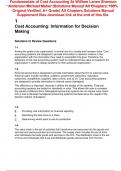Exam (elaborations)
Solutions Manual For Fundamentals of Cost Accounting 5th Edition By William Lanen Shannon Anderson Michael Maher (All Chapters, 100% Original Verified, A+ Grade)
- Course
- Institution
This Is The Original 5th Edition Of The Solution Manual From The Original Author All Other Files In The Market Are Fake/Old Editions. Other Sellers Have Changed The Old Edition Number To The New But The Solution Manual Is An Old Edition. Solutions Manual For Fundamentals of Cost Accounting 5th ...
[Show more]



